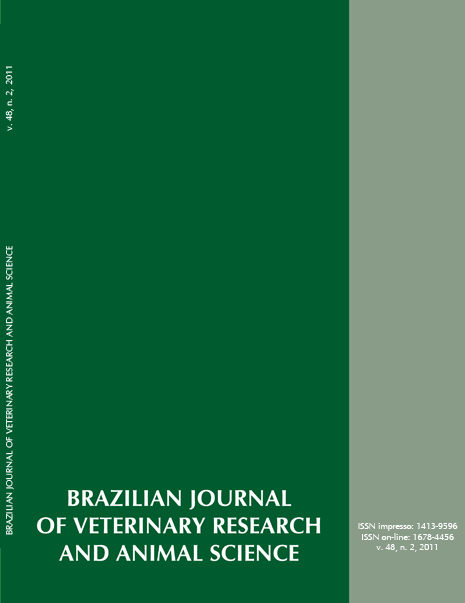Multiple substitutions in biologically active domains of rabies virus glycoprotein can be related to pathogenic profile
DOI:
https://doi.org/10.11606/S1413-95962011000200005Keywords:
Bats, Glycoprotein, Pathogenicity, Phylogeny, RabiesAbstract
Pathogenic profile of a rabies virus isolated from an insectivorous bat Lasiurus ega was compared with a rabies fixed virus strain (CVS/32) in hamster and mouse. Incubation and clinical periods, clinical manifestation and death rates were compared. Challenge of hamsters with L. ega was performed using: 10 2,611-4,021 LD50 /0,05 mL;. For CVS were used 10 3,7- 4,7 LD50 /0,05 mL. Were tested intramuscular (IM), intradermal (ID), intranasal (IN), epidermal abrasion (EA) inoculation routes. Viral antigen in brains was confirmed by Direct Immunofluorescence Test. Mortality percentages observed with L. ega rabies virus isolate were the following in hamster: 3,5 % IM, 10,710% IN; in mice: 50.0% IM, 30.0% IN. Furious rabies was predominant. Mortality percentages observed with CVS/32 in hamster: 12.5% IM, 62.5% ID, 12.5% IN; in mice 100.0% IM, 70.0% ID, 10.0% IN. Paralytic rabies was found with this strain in both animal models. Epidermic abrasion was not a suitable challenge route. Incubation period was 5-7 days for CVS and 11-16 days for L. ega isolate, meanwhile clinical periods were comprehended between 47 days for both viruses. Several substitutions were detected at antigenic domains of glycoprotein: AI (position 231), AII (3442 and 198-200), domain of fusion dependent on low pH (102179), transmembrane domain (440461) and residue 242. These viruses showed contrasting biological behaviors that can be linked to those substitutions at antigenic domains previously described.Downloads
Downloads
Published
2011-04-01
Issue
Section
UNDEFINIED
License
The journal content is authorized under the Creative Commons BY-NC-SA license (summary of the license: https://
How to Cite
1.
Garcia AIE, Mochizuki N, Brandão PE, Albas A, Ito FH. Multiple substitutions in biologically active domains of rabies virus glycoprotein can be related to pathogenic profile. Braz. J. Vet. Res. Anim. Sci. [Internet]. 2011 Apr. 1 [cited 2025 Apr. 6];48(2):131-40. Available from: https://www.revistas.usp.br/bjvras/article/view/34364





